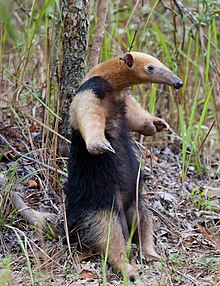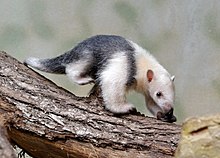Southern tamandua
| Southern tamandua[1] | |
|---|---|

| |
| In defensive posture | |
| Scientific classification | |
| Domain: | Eukaryota |
| Kingdom: | Animalia |
| Phylum: | Chordata |
| Class: | Mammalia |
| Order: | Pilosa |
| Family: | Myrmecophagidae |
| Genus: | Tamandua |
| Species: | T. tetradactyla
|
| Binomial name | |
| Tamandua tetradactyla | |

| |
| Southern tamandua range | |
| Synonyms | |
|
Myrmecophaga tetradactyla Linnaeus, 1758 | |
The southern tamandua (Tamandua tetradactyla), also called the collared anteater or lesser anteater, is a species of anteater from South America and the island of Trinidad in the Caribbean. It is a solitary animal found in many habitats, from mature to highly disturbed secondary forests and arid savannas. It feeds on ants, termites, and bees. Its very strong foreclaws can be used to break insect nests or to defend itself.
Distribution and habitat
[edit]The southern tamandua is found in Trinidad and throughout South America from Venezuela to northern Argentina, southern Brazil, and Uruguay at elevations up to 1,600 m (5,200 ft). It inhabits both wet and dry forests, including tropical rainforest, savanna, and thorn scrub.[4] It seems to be most common in habitats near streams and rivers, especially those thick with vines and epiphytes (presumably because its prey is common in these areas).[citation needed]
The oldest fossil tamanduas date from the Pleistocene of South America, although genetic evidence suggests they may have diverged from their closest relative, the giant anteater, in the late Miocene, 12.9 million years ago.[5]
Subspecies
[edit]The four recognised subspecies of Tamandua tetradactyla are:
- T. t. tetradactyla (Linnaeus, 1758): southern and eastern Brazil, Uruguay
- T. t. nigra (Geoffroy, 1803): northern Brazil, Colombia, Venezuela, Trinidad, the Guianas
- T. t. quichua (Thomas, 1927): Peru, Ecuador, extreme western Brazil
- T. t. straminea (Cope, 1889): southern Brazil, Paraguay, Bolivia, Argentina
Physical description
[edit]

The southern tamandua is a medium-sized anteater, though it can vary considerably in size based on environmental conditions. It has a head and body length ranging from 34 to 88 cm (13 to 35 in), and a prehensile tail 37 to 67 cm (15 to 26 in) long. Adults weigh from 1.5 to 8.4 kg (3.3 to 18.5 lb), with no significant difference in size between males and females.[4][6] Like their close relative, the northern tamandua, they have four-clawed digits on the forefeet and five on the hind feet and walk on the outer surfaces of their forefeet to avoid puncturing their palms with their sharp claws. The underside and the tip of the tail are hairless. The snout is long and decurved with an opening only as wide as the diameter of a stick, from which the tongue is protruded. Although some differences in the shape of the skull are seen, they can most easily be distinguished from the northern tamandua by their slightly longer ears, which average around 5 cm (2.0 in) instead of 4 cm (1.6 in), as in the northern species.[4]
The individual and geographic variation observed in the southern tamandua have made the taxonomic description of these animals a difficult task. Animals from the southeastern part of the range are "strongly vested", meaning they have black markings from shoulder to rump; the black patch widens near the shoulders and encircles the forelimbs. The rest of the body can be blonde, tan, or brown. Animals from northern Brazil and Venezuela to west of the Andes are solid blonde, brown, or black, or are only lightly vested. Individuals from Trinidad are almost always solid blonde.[citation needed]
Reproduction
[edit]Females are polyestrous; mating generally takes place in the fall. The estrous cycle will last approximately about 42 days. Gestation ranges from 130 to 190 days.[4] The female gives birth to one offspring per year.[7] At birth, the young anteater does not resemble its parents; its coat varies from white to black. It rides on the mother's back for several months up to a year and is sometimes deposited on a safe branch while the mother forages.
Behavior
[edit]
The tamandua is mainly nocturnal but is occasionally active during the day. The animals nest in hollow tree trunks or in the burrows of other animals, such as armadillos. They are solitary, occupying home ranges that average from 100 to 375 ha (250 to 930 acres), depending on the local environment.[4]
They may communicate when aggravated by hissing and releasing an unpleasant scent from their anal glands. They spend much of their time foraging arboreally; a study in various habitats in Venezuela[citation needed] showed this anteater spends 13 to 64% of its time in trees. The southern tamandua is quite clumsy on the ground and ambles along, incapable of the gallop its relative, the giant anteater, can achieve.
The southern tamandua uses its powerful forearms in self-defense. If it is threatened in a tree it grasps a branch with its hindfeet and tail, leaving its arms and long, curved claws free for combat. If attacked on the ground, this anteater backs up against a rock or a tree and grabs the opponent with its forearms. In the rainforest, the southern tamandua is surrounded during the day by a cloud of flies and mosquitoes and is often seen wiping these insects from its eyes.[citation needed] This animal has small eyes and poor vision, but its large, upright ears indicate that hearing is an important sense.
The southern tamandua is a host of the acanthocephalan intestinal parasites Gigantorhynchus echinodiscus, Gigantorhynchus lopezneyrai, and Gigantorhynchus ungriai.[8]
Diet
[edit]Southern tamanduas eat ants and termites in roughly equal proportions, although they may also eat a small quantity of fruit. They locate their food by scent, and prey on a wide range of species, including army ants, carpenter ants, and Nasutitermes.[4] They avoid eating ants armed with strong chemical defenses, such as leafcutter ants.[citation needed] They also consume beetle larvae and their water requirement is obtained through their food.[9] But as with the ants, beetles with a chemical defense are generally avoided.[9] Evidence also suggests that southern tamanduas in captivity prefer termites over ants whilst Tamanduas examined in the wild consume a larger quantity of ants than termites.[10][11] Anteaters extract their prey by using their extremely strong fore limbs to rip open nests and their elongated snouts and rounded tongues (up to 40 cm (16 in) in length) to lick up the insects. These tongues are adapted specifically for myrmecophagy thanks to specialized papillae that allow them to grab onto their tiny prey.[12]
Although it has the same diet as the giant anteater, both animals are able to live alongside one another, perhaps because the southern tamandua is able to reach nests in trees, while its larger relative cannot.[4]
Conservation
[edit]Although widespread, they are uncommon. They are killed by hunters, who claim the tamanduas kill dogs. They are also killed for the thick tendons in their tails, from which rope is made. Tamanduas are sometimes used by Amazonian Indians to rid their homes of ants and termites.[citation needed]
Citations
[edit]- ^ Gardner, A. L. (2005). "Order Pilosa". In Wilson, D. E.; Reeder, D. M. (eds.). Mammal Species of the World: A Taxonomic and Geographic Reference (3rd ed.). Johns Hopkins University Press. p. 103. ISBN 978-0-8018-8221-0. OCLC 62265494.
- ^ Miranda, F.; Fallabrino, A.; Arteaga, M.; Tirira, D.G.; Meritt, D.A.; Superina, M. (2014). "Tamandua tetradactyla". IUCN Red List of Threatened Species. 2014: e.T21350A47442916. doi:10.2305/IUCN.UK.2014-1.RLTS.T21350A47442916.en. Retrieved 12 November 2021.
- ^ Linnæus, Carl (1758). Systema naturæ per regna tria naturæ, secundum classes, ordines, genera, species, cum characteribus, differentiis, synonymis, locis. Tomus I (in Latin) (10th ed.). Holmiæ: Laurentius Salvius. p. 35. Retrieved 23 November 2012.
- ^ a b c d e f g Hayssen, V. (2011). "Tamandua tetradactyla (Pilosa: Myrmecophagidae)". Mammalian Species. 43 (1): 64–74. doi:10.1644/875.1.
- ^ Barros, M.C.; et al. (2003). "Phylogenetic analysis of 16S mitochondrial DNA data in sloths and anteaters". Genetics and Molecular Biology. 26 (1): 5–11. doi:10.1590/S1415-47572003000100002.
- ^ Burnie D and Wilson DE (Eds.), Animal: The Definitive Visual Guide to the World's Wildlife. DK Adult (2005), ISBN 0789477645
- ^ Bernegossi, Agda Maria (February 8, 2018). "Evaluation of collared anteaters (Tamandua tetradactyla) presented in a wildlife health reference center of Sao Paulo state, Brazil" (PDF).
- ^ Nascimento Gomes, Ana Paula; Cesário, Clarice Silva; Olifiers, Natalie; de Cassia Bianchi, Rita; Maldonado, Arnaldo; Vilela, Roberto do Val (December 2019). "New morphological and genetic data of Gigantorhynchus echinodiscus (Diesing, 1851) (Acanthocephala: Archiacanthocephala) in the giant anteater Myrmecophaga tridactyla Linnaeus, 1758 (Pilosa: Myrmecophagidae)". International Journal for Parasitology: Parasites and Wildlife. 10: 281–288. Bibcode:2019IJPPW..10..281N. doi:10.1016/j.ijppaw.2019.09.008. PMC 6906829. PMID 31867208.
- ^ a b "Tamandua tetradactyla (Southern Tamandua or Lesser Anteater)" (PDF). sta.uwi.edu.
- ^ Zárate, Valentín; Mufari, Jesica R.; Abalos Luna, Lucía G.; Villarreal, Daniel P.; Busso, Juan M. (2022-01-05). "Assessment of Feeding Behavior of the Zoo-Housed Lesser Anteater (Tamandua tetradactyla) and Nutritional Values of Natural Prey". Journal of Zoological and Botanical Gardens. 3 (1): 19–31. doi:10.3390/jzbg3010002. ISSN 2673-5636.
- ^ Deloss, Andressa Xavier Rodrigues; Dröse, William; Rocha, Mauricio M.; Peters, Felipe Bortolotto; Kasper, Carlos Benhur (2023-04-30). "Feeding habits of the lesser anteater Tamandua tetradactyla (Pilosa: Myrmecophagidae) in the Brazilian Pampa". Studies on Neotropical Fauna and Environment. 59 (2): 457–463. doi:10.1080/01650521.2023.2204714. ISSN 0165-0521. S2CID 258445902.
- ^ Casali, Daniel M.; Martins-Santos, Elisângela; Santos, André L. Q.; Miranda, Flávia R.; Mahecha, Germán A. B.; Perini, Fernando A. (October 2017). "Morphology of the tongue of Vermilingua (Xenarthra: Pilosa) and evolutionary considerations". Journal of Morphology. 278 (10): 1380–1399. doi:10.1002/jmor.20718. ISSN 0362-2525. PMID 28643449. S2CID 13644895.
General sources
[edit]- Emmons, Louise H.; Feer, François (1997-09-02). Neotropical Rainforest Mammals: A Field Guide (2nd ed.). Chicago: University of Chicago Press. pp. 39–41. ISBN 978-0-226-20721-6. OCLC 44179508.
- Gorog, A. 1999. "Tamandua tetradactyla" from Animal Diversity Web.
External links
[edit] Data related to Tamandua tetradactyla at Wikispecies
Data related to Tamandua tetradactyla at Wikispecies Media related to Tamandua tetradactyla at Wikimedia Commons
Media related to Tamandua tetradactyla at Wikimedia Commons
- IUCN Red List least concern species
- Anteaters
- Mammals of the Caribbean
- Mammals of Argentina
- Mammals of Bolivia
- Mammals of Brazil
- Mammals of Colombia
- Mammals of Ecuador
- Mammals of French Guiana
- Mammals of Guyana
- Mammals of Paraguay
- Mammals of Peru
- Mammals of Suriname
- Mammals of Trinidad and Tobago
- Mammals of Uruguay
- Mammals of Venezuela
- Fauna of the Amazon
- Mammals described in 1758
- Taxa named by Carl Linnaeus

